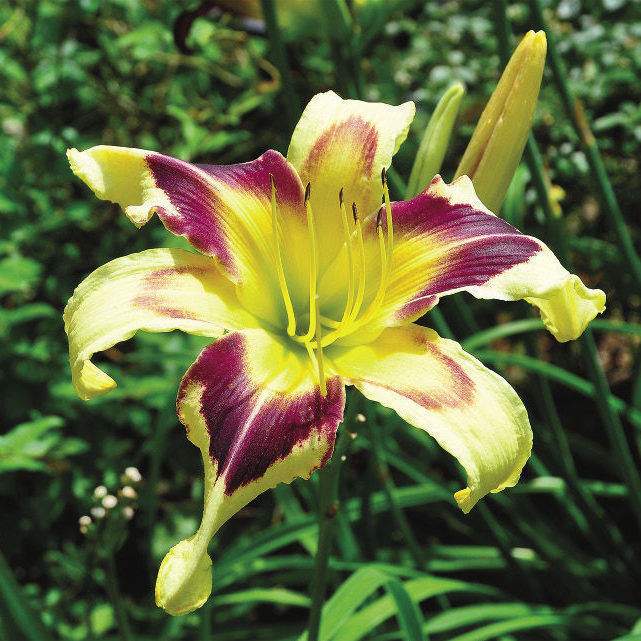
1. Hollyhock
Name: Alcea rosea cvs.
USDA Hardiness Zones: 3 to 9
Size: 5 to 8 feet tall and 1 to 2 feet wide
Conditions: Full sun; fertile, well-drained soil
From double- to single-flowering plants, hollyhock is back in fashion. It is easy to start from seed and, once established, will self-sow for years. I grow single-flowering types to encourage more pollinators. There’s nothing like watching a fat bumblebee grab the flower and vibrate pollen from it. Sow seed indoors in small pots, press into soil, and lightly cover. You can also direct-sow in the garden and thin to the strongest plant. Hollyhock can be plagued by rust in moist areas, so keep its leaves dry.

2.‘Burgundy’ blanket flower
Name: Gaillardia ‘Burgundy’
Zones: 3 to 8
Size: 2 to 3 feet tall and 2 feet wide
Conditions: Full sun; sandy, unamended, dry soil; drought tolerant once established
Not your average blanket flower, ‘Burgundy’ is an intense red that holds its color well in a hot and dry climate. The center is dark red with a bright yellow dot. Due to its daisylike shape, blanket flower is attractive to butterflies and other pollinators. Sow seeds outdoors after frost, or get a jump start on the season and sow seeds indoors five to six weeks before the last frost date. Cover seeds lightly with soil, and keep moist. After plants are 2 inches tall and have two or three sets of leaves, place them outside in full sun in an area with sharp drainage. This plant can be short-lived in some climates.

3. Daylily
Name: Hemerocallis spp. and cvs.
Zones: 3 to 10
Size: 1 to 5 feet tall and 2 feet wide, depending on the cultivar
Conditions: Full sun; moist, fertile, well-drained soil amended with nitrogen to increase clump size; tolerates clay
If you ever wanted to create your own plants, daylily is among the easiest to propagate—hence, the multitude of cultivars (‘Hold Your Horses’, pictured). Buy seeds online, or hand-pollinate by brushing pollen from one flower onto the pistil of another. Once pods turn dark and begin to split, seeds are ripe and ready to plant. Seeds can be direct-sown outdoors in a protected area or grown in starter pots of sterile potting soil, either outdoors in a shaded area or inside under lights. Seeds germinate in about two weeks, but it takes about two years for a daylily to bloom from seed. There is no plant with a wider range of form and color than daylily. The only color it doesn’t come in is true blue.

4. ‘Summer Sorbet’ mullein
Name: Verbascum ‘Summer Sorbet’
Zones: 5 to 8
Size: 2 feet tall and 12 to 18 inches wide
Conditions: Full sun; lean, alkaline, well-drained soil
Mulleins can be annual, biennial, or perennial. ‘Summer Sorbet’ is a short-lived perennial in our prairie climate, so grow it each year for seeds. Scatter the seeds under lights indoors in January, and place outdoors after frost. Mullein-moth larvae can be a problem early in the season before additional leaves emerge; I pick them off and dispose of them either by feeding them to my chickens or dropping them in soapy water. Deadhead to increase flower spikes. Although seed sources describe the flower color as raspberry with a peach or melon center, I notice a variety of colors, including pale lavender.
Photos, except where noted: courtesy of Dee Nash, Michelle Gervais, Jerry Pavia, Bill Johnson
Fine Gardening Recommended Products

Burpee Organic Coconut Coir Concentrated Seed Starting Mix, 16 Quart
Fine Gardening receives a commission for items purchased through links on this site, including Amazon Associates and other affiliate advertising programs.

Chapin International 10509 Upside-Down Trigger Sprayer
Fine Gardening receives a commission for items purchased through links on this site, including Amazon Associates and other affiliate advertising programs.

Deep 72 Cell Seedling Trays (10-Pack)
Fine Gardening receives a commission for items purchased through links on this site, including Amazon Associates and other affiliate advertising programs.


















Comments
Log in or create an account to post a comment.
Sign up Log in